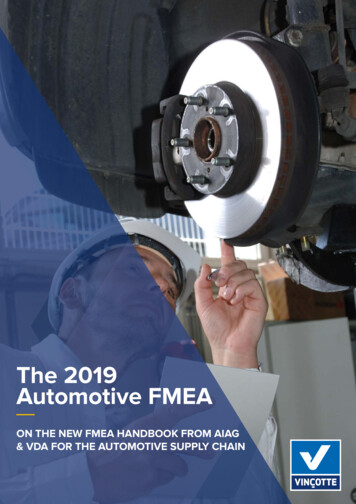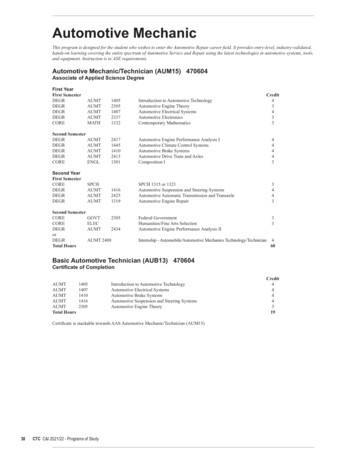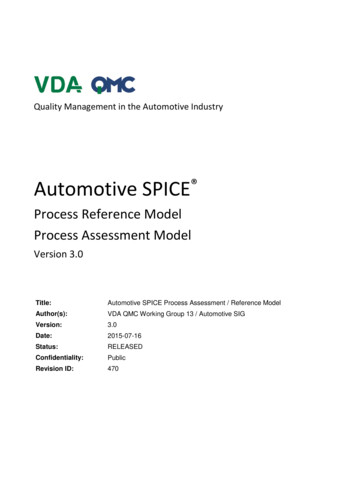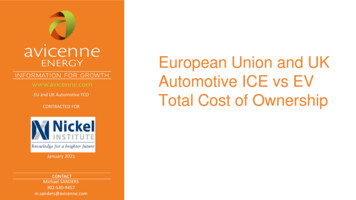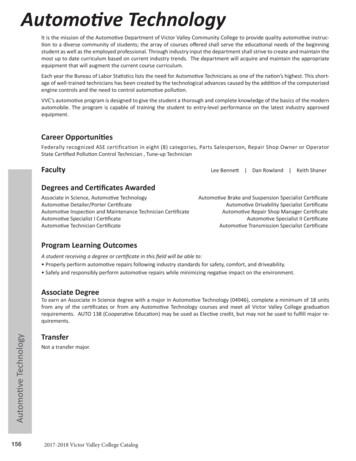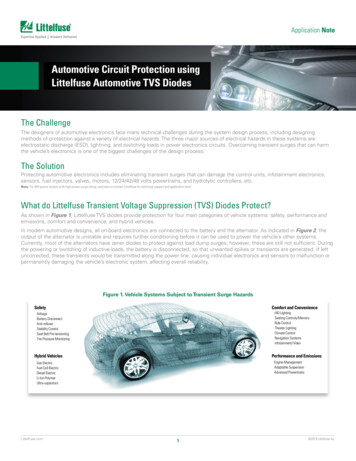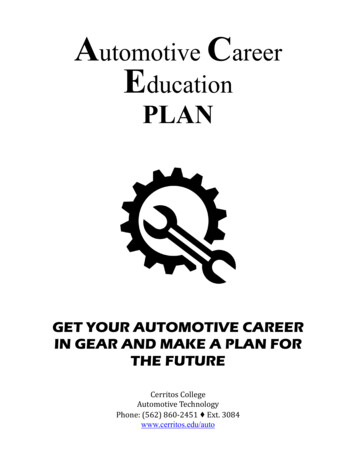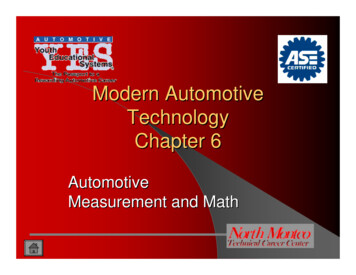
Transcription
AU TOM OT IV E M AR K ETI N G20 1 9 EB O O K(800) 523-7346 // info@v12data.com // www.v12data.com
AUTOMOTIVE MARKETING EBOOKCONTENTSA New Automotive Landscape. 3How Consumers Shop for Cars. 4-9Online Car Shopping and Social. 6Dealerships. 7Mobile Activity. 8Car Buying and Millennials. 9Automotive Customer Journey. 10Data Fueling the Auto Industry. 11Marketing Data. 12V12 AutoID. 13In-Market Indicators. 14V12 Signals. 15-16Mobile Signals Traffic Volumes. 16In-Market Model. 17Auto Buyer’s Journey. 18-25The Three Stages of Purchase. 19Awareness. 20Types of Content to Drive Conversions. 21V12 AudienceLink for Facebook. 22Target Acquisition Audiences. 23Target First Party & Look-Alike Audiences. 24Consideration. 25Decision. 25Marketing Challenges Along the Path to Purchase. 26V12 Velocity for Automotive. 27Automate Customer Journeys. 28Customer Experience: The Ultimate Deciding Factor. 29Conclusion. 29About V12. 30
AUTOMOTIVE MARKETING EBOOKA NEW AUTOMOTIVE LANDSCAPEThe automotive industry has seen a seismic shift as new technology and massive amounts ofdata flood the evolving landscape. Changing consumer behaviors, trends toward alternatetypes of mobility, and the convergence of the online and offline world have empoweredtoday’s automotive consumer, placing them firmly in charge of the experiences they nowdemand from automotive brands.Similarly, the car buying process has seen radical changes. What once began with readingnewspaper ads and driving from dealer to dealer has changed dramatically, with consumersnow using multiple devices and multiple channels to research and make decisions well beforemaking initial contact with a dealer.3
AUTOMOTIVE MARKETING EBOOKHOW CONSUMERS SHOP FOR CARSAccording to recent Autotrader statistics,car buyers spend 59% of their time researchingonline. And, while they are researching online,46% of them use multiple devices. Most carbuyers are undecided at the start of the shoppingprocess. When they first begin to shop, 6 out of10 them are open to considering multiplevehicle options.Third-party sites are the most used sites for car6 out of 10 CarBuyers are opento consideringmultiple vehicleoptions. (Autotrader)shopping, used by 78% of shoppers. (Autotrader)The top five activities conducted online by carshoppers include researching car prices (71%),finding actual cars listed for sale (68%), comparingdifferent models (64%), finding out what theircurrent car is worth (63%), and locating a dealeror getting dealer info (46%). (Autotrader)Walking in remains the common form of initialcontact with a dealership by more than half ofcar shoppers.Initial Contact with the Dealership56%Walk-In61%54%25%Phone20%28%Sources Used to Shop78%74%80%3rd Party SalesOEM SitesOnline Chat(a live %13%Email*NewUsed*Respondants were asked “Please select the names of the specific website/apps that you used.”Some selected more than one answer.3%3%3%1%1%1%1%Social Media 0%1%TotalNewUsed4
AUTOMOTIVE MARKETING EBOOKOnce a consumer arrives at the dealership, 71% of buyers statedthat they are satisfied with the overall dealership experience.Shoppers were most satisfied with the test driving process (77%).The biggest room for improvement includes interactions withthe financing department (59%) and satisfaction with how long the process took (46%). (AutoTrader)SATISFACTION WITH OVERALL DEALERSHIP EXPERIENCEYour overall experiencewith the dealershipALL BUYERSNEWUSED71%75%69%SATISFACTION WITH DEALERSHIP PROCESSThe test-drivingprocessInteractions withdealership sales peopleThe selectionof inventory availableInteractions with thefinancing department00:00How long the process tookALL 6%50%45%5
AUTOMOTIVE MARKETING EBOOKONLINE CAR SHOPPING AND SOCIALAmong automotive internet shoppers, 22% use a socialmedia site as a source while shopping for their newvehicle, up from 16% in 2015. The most popular socialmedia sites used by auto internet shoppers during theshopping process are YouTube (13%), DealerRater (7%) andFacebook (5%). (JD Power Autoshopper Study)Among automotive internet shoppers who use socialmedia, only 13% indicate that the information posted onsocial media sites influenced their purchase decision, andonly 2% say a social site was the “most useful site” theyvisited. (JD Power Autoshopper Study)Slightly more than one-third (34%) of new-vehicle buyersusing social media for automotive information post a34% of new-vehicle buyers usingsocial media for automotiveinformation post a picture oftheir new vehicle on a social site.(JD Power Autoshopper Study)picture of their new vehicle on a social site. Facebook is byfar the most posted site at 88%, followed by Instagram at21%. (JD Power Autoshopper Study)When asked about newer car buying alternatives, 54%said they would “love” being able to sell or buy a car fromhome and 42% were fine buying a car without a testdrive, as long as there was some form of guarantee. (BeepiConsumer Automotive Index)Research that Google commissioned from MillwardBrown Digital indicates that 70% of people who used54%of new-vehiclebuyers said theywould “love” being able to sellor buy a car from home.(Beepi Consumer Automotive Index)YouTube as part of their car buying process wereinfluenced by what they watched and views onYouTube of test drives, features and options, and walkthroughs have doubled in the past year.6
AUTOMOTIVE MARKETING EBOOKDEALERSHIPS87% of Americans dislike something about carWhat is the highest priority for yourdealerships marketing efforts?shopping at dealerships and 61% feel they’re takenadvantage of while there.(Beepi Consumer Automotive Index)When asked about newer car buying alternatives,Increasing Volume of LeadsImproving Conversion54% said they would “love” being able to sell orbuy a car from home and 42% were fine buying acar without a test drive, as long as there was someform of guarantee. (Beepi Consumer AutomotiveReducing Cost of AcquisitionIncreasing Revenue from LeadsIndex)None of the AboveFor automotive dealers, the biggest marketing0%10%20%30%40%50%priority by far is increasing lead volumeand conversions.(9 Clouds, “State of Automotive Marketing”)Dealerships are also utilizing the data theyhave on hand prior to contacting a prospect.The most common pieces of consumerdata include basic contact details, vehicleinterest, and purchase/service history.(9 Clouds, “State of Automotive Marketing”)54% of consumers would buy from adealership that offers their preferredHow much info does your company have abouta lead before a salesperson reaches out?Basic Contact InfoInterested Vehicle InfoPurchase / Service HistoryWeb Interaction HistorySocial Media Info0%10%20%30%40%50%60%70%80%90%experience, even if it didn’t have the lowestprice. (Autotrader)72% would visit dealerships more often if the buying process was improved. (Autotrader)According to a study by Arthur D. Little, dealers average response time to consumers is 9.2 hours and OEMsaverage time is around 24 hours. This is a huge opportunity for improving the overall customer experience.7
AUTOMOTIVE MARKETING EBOOKMOBILE ACTIVITYAccording to research from Facebook, US vehicleshoppers not only use mobile devices as theyresearch new cars, they even prefer them for someactivities. A majority of vehicle shoppers, for example,said mobile was a better way to ask friends and familyabout auto options, and about two in five preferredto book a test drive from a mobile device.Smartphones Surpass Tablets for AutomotiveResearch: More than half (53%) of automotiveinternet shoppers use a mobile device in their questfor automotive information. For 2016, smartphoneusage surpasses tablet usage (37% vs. 33%,respectively). The use of desktop or laptop computersremains most common at 92% but has been steadilydecreasing from 99% in 2012. Consequently, theproportion of time spent shopping on mobile devicescontinues to increase, with 33% of the total shoppingtime now conducted on a mobile device. (JD PowerAutoshopper Study)Integrated mobile apps and connected vehicleservices deliver more value for the customer,enhancing customer loyalty after the initial carpurchase. A study by DMEautomotive showed thatvehicle buyers using a branded app were 73% morelikely to make a purchase from the dealership, andafter making a purchase, booked 25% more service6 out of 10 CarBuyers are opento consideringmultiple vehicleoptions. (Autotrader)appointments than shoppers without an app. Theyalso spent more money than non-app users whenpurchasing a vehicle, 7% more according to a studycommissioned by Cars.com.8
AUTOMOTIVE MARKETING EBOOKCAR BUYING AND MILLENNIALSWhen looking to buy, Millennials consider slightlymore vehicles on average than Baby Boomers.Millennials also usually take longer to decide whatcar to buy than Baby Boomers, an average of 16.9 vs15.7 weeks. Millennials invest more time in the actualbuying process as well, almost four and a half hoursmore on average. (D. Power)52% of car shoppers feel anxious or uncomfortable at56% OF MILLENNIALSwould rather clean theirhomes than negotiatewith a car dealer.(Beepi Consumer Automotive Index)dealerships. Millennials lead the pack in their dislike, with56% saying they’d rather clean their homes than negotiatewith a car dealer. Gen X-ers aren’t fans either, and facedwith alternatives 24% say they’d rather have a root canalthan get into car negotiation. Among millennial women,62% feel pressured to buy right away and 49% said theyfelt tricked into buying features they didn’t need. (BeepiConsumer Automotive Index)Vehicle ownership plays a key role in supportingMillennials’ need to stay connected, and in a studyby Autotrader.com, 72% of younger millennialsindicated that a car is important to their social life.Style and features, especially technology, are criticallyimportant to them. For example, more than 70% ofyounger millennials cite technology and infotainmentfeatures as “must-haves” when purchasing a car. Areport by automotive research company, SBD providesevidence that these connected systems are importantto younger, more digitally oriented consumers andwill likely impact their next vehicle brand purchasedecision.9
AUTOMOTIVE MARKETING EBOOKAUTOMOTIVE CUSTOMER JOURNEYA study by ACA Research maps out the automotive customer journey and the timing for key events frominitial research to final purchase.According to the research, “Generally the automotive vehicle purchase journey for the vehicle andfinance can take between 5 and 12 weeks and encompasses thefollowing steps:”1. Develop a shopping list of vehicle brandsApprox. 1-3 months prior to purchase2. Cull the shortlist4-7 weeks before purchase3. Test drive vehicles2-4 weeks before purchase4. Finalize vehicle choice1-3 weeks before purchase (on average)10
AUTOMOTIVE MARKETING EBOOKDATA FUELING THE AUTO INDUSTRYIt goes without saying that auto companies mustbe more committed than ever to understanding84%sets and analytical capabilities to develop a rich,of executivesabsolutely or partlyagree that data is the fuel forthe future business model ofauto companies.omnichannel customer view.(KPMG’s Global Automotive Executive Survey)today’s consumers on a one-to-one level,including what drives them, what motivates them,and what they are looking for in their next vehicle.Developing an understanding of consumers atsuch a personalized level requires numerous dataIn KPMG’s Global Automotive Executive Survey,automotive executives were on the samepage about the value of data. According to theresearch, “84% of executives absolutely or partlyagree that data is the fuel for the future businessmodel of auto companies.”11
AUTOMOTIVE MARKETING EBOOKMARKETING DATAConsumers produce mountains of data every day–information about who they are, their intent topurchase, and more. Automotive brands must be diligent in collecting data from each consumerengagement such as visits to the service department, calls to customer service, email engagement, formfills, inquiries on available vehicles and more. Each of these data points should be integrated into a CRMsystem in order to better understand current and prospective customers.Appending third-party data assets to an internal database will provide a much deeper understanding of abrand’s customer base. Examples of third-party data sets include:Demographic Data: Information such as households with new children (might upgrade to a larger vehicle),teenage drivers (might purchase a first car), or lifestyle attributes, such as environmentalism or an interestin the outdoors (hybrids or four-wheel drive), can take targeted marketing to the next step. Income, maritalstatus, occupation, hobbies, lifestyle, and age are other examples of demographics that can be used tocreate targeted marketing messages to which consumers are most apt to relate.VIN Marketing Data: Information on vehicles and their owners, such as make, model, and year, or datasuch as engine size, fuel type, drive train, engine block, and engine cylinders.12
AUTOMOTIVE MARKETING EBOOKV12 provides the industry’s leading VIN database with data on over 215 million consumers and 186 million VINs with linkage at the household and garage level. VIN data is available for all 50 states,including privacy states and is 100% populated with Make, Model and Year. Unlike other providers whomerely attempt to model the most likely vehicle for their garage data, V12 determines EXACT VIN(s)belonging to a specific garage. Multiple other selections are also available including engine size, fuel type,drive train, engine block, and engine cylindersTrigger Data:Consumers who might be in-market for a new vehicle based on life events, such as new movers, newteen drivers, newly married, or newly retired. Nearly three-quarters of new movers make major moverelated-purchases. For example, in the automotive industry: Auto dealers and repair shops rank among the top five most-sought-after gift certificates includedwithin new mover marketing welcoming packages. Hundreds of auto retailers and repair shops nationwide generate an average monthly response rate of12% using new mover marketing programs. Auto-focused new mover offers like “one free oil change” and “one free car wash” rank among the top10 best-performing offers. New movers are 90% more likely than established residents to purchase a car within the first year oftheir move. (Source: Zillow)V12 provides mover solutions spanning the entire move cycle.Other types of trigger data V12 offers include:New Parent 4.5MMChild NearHigh school Graduation5.3MMNew Mover 27MMCollege Graduate 6.4MMRecent Divorce 1MMNewly Wed 2.8MM13
AUTOMOTIVE MARKETING EBOOKIN-MARKET INDICATORSOne of the most powerful types of data is purchase intent. Google found that marketers who only try toreach their audience with demographics are missing at least 70% of shoppers.While demographics are incredibly important, they only show brands what the consumer looks like today,not what they may be in market to purchase tomorrow. Purchase intent is the likelihood of an individualbuying a specific item and can be identified through purchase signals consumers leave across thepurchase journey.14
AUTOMOTIVE MARKETING EBOOKV12’s purchase intent solution, V12 Signals, allows marketers to reach car shoppers who areexpressing active, in-the-moment intent to purchase.Reach 1.7 million monthly car shoppers.Using mobile location intelligence, dealerships can reach shoppers who have recently visited theirlot or a competitor’s location. V12 Signals is an innovative mobile solution that enables companiesto market to households expressing active intent to purchase based on their shopping behavior.Specifically, we utilize geolocationdata to identify in-market shoppingactivity. We then use our proprietaryintegration technology to identifythe likely in-market household.Unlike traditional mobile marketing,which only identifies the device, V12Signals identifies households and theindividuals in them.Our innovative solution provideshousehold contact informationcomplete with a wide variety ofconsumer attributes allowing you tocreate a highly targeted offer acrossmultiple channels.How does it work?97% percent of consumers own and carry a mobile device, the majority of which have multipleapplications installed. When installing certain apps, consumers must opt-in to grant permission forlocation tracking. When a consumer drives to a location and has one of these apps available on theirmobile device, V12 Signals is able to identify that device at the location and subsequently infer thehousehold associated with the shopping event.Clients using V12 Signals have experienced3x higher engagement and 19% sales conversions.15
AUTOMOTIVE MARKETING EBOOKMOBILE SIGNALS TRAFFIC VOLUMESBelow is an example of monthly Signals traffic volume for automotive.BrandTotal VisitsUnique VisitsAcura38,77521,953Alfa Romeo11,7053,788Aston 57,13716
AUTOMOTIVE MARKETING EBOOKIN-MARKET MODELV12 is also able to help brands reach vehicle shoppers with our in-market model, which identifiesshoppers 4.2x more likely than the average U.S. population to purchase a vehicle within a 90-daytime frame.The model was built using V12 Signals mobile location technology. Using machine-learningprocesses, the model is continually ingesting this feed of in-market behavioral data to deliverpredictions and recalibrate.As part of the development process, V12 Signals data was validated against verified auto purchasedata. Research done in conjunction with a third-party research partner revealed that consumers withmultiple visits to a dealer within a two-month time period are more likely to purchase a vehicle in thenext 90 days compared to consumers with only a single visit. Based upon this data, consumers with 4 sales visits have a much higher purchase rate compared to consumers with fewer visits.V12’s VIN database, V12 AutoID, provides the foundation for the in-market automotive model.V12 Signals Consumers by Number of Visitsand Indexed Purchased RatePercent of Consumers with a Signal70%Indexed Percent with a 0%10%0%12011130%160606.2%9.2%402001 Visit1 Visit3 Visit4 Visits
AUTOMOTIVE MARKETING EBOOKAUTO BUYER’S JOURNEYToday’s consumers are empowered with moreinformation and choices than ever before. Fromawareness to purchase, automotive shoppers takean omnichannel journey before stepping into adealership, ready to sign. This journey can takeweeks or even months before a purchase decisionis made. Marketers must understand this process40% OF AUTOSHOPPERS arein-market for2-6 months.and target consumers throughout every phase toensure their brand will make the short-list whenit’s time for the final decision.18
AUTOMOTIVE MARKETING EBOOKTHE THREE STAGES OF PURCHASEAWARENESS, CONSIDERATION, DECISION. The buyer’s journey is the process a consumer goesthrough from awareness of a need, to consideration of different options, and finally to the decisionto act. As a consumer goes through each of these stages, dealerships must ensure they have a strongpresence across multiple channels and are reaching consumers with the right messages and offers.According to Google’s examination of one consumer’s path to vehicle purchase, the auto purchasejourney can cover over 900 digital touchpoints in a three-month period.19
AUTOMOTIVE MARKETING EBOOKAWARENESSIn this stage, buyers are aware of a need. More trips to the repair shop may trigger the decision topurchase a new vehicle to offset accumulating repair costs. A new teen driver may be ready for theirfirst car, a new baby may mean a larger family vehicle, or a newly retired couple could be ready for anupgraded model with advanced safety features.Whatever the reason, when a consumer first enters the market for a new vehicle, chances are they aremost likely unaware of your dealership. This means that as prospects begin to search for options, autocompanies need to have a strong presence.This initial phase of awareness is the ideal time to make a solid impression. A robust website, valuablecontent on multiple sites, and a social media engagement strategy are integral to giving auto companiesa competitive edge.Content marketing plays an essential role throughout the car buying journey. Many dealerships utilizetop of the funnel content strategies such as blog posts and articles to improve search engine rankings.However, it is increasingly important for automotive dealerships to integrate other types of content todrive conversions. Based upon research by Cox Automotive, consumers are looking for content including: 71% – Research car pricing 68% – Find actual vehicles listed for sale 64% – Compare different models 63% – Find out what current car is worth 46% – Locate a dealer or get dealer info20
AUTOMOTIVE MARKETING EBOOKTYPES OF CONTENT TO DRIVE CONVERSIONSPHOTOS: Ten photos on a Vehicle Detail Page (VDP) can increase page views by 142% and increasedealer contacts by 117%. The more photos displayed of each vehicle, the better the car shopper’sexperience. (NIADA)PRICES: The top reason car buyers use online sources to shop for vehicles is to research pricing. (IHS/Polk)VIDEOS: 25% of all new shoppers spend one hour or more watching videos while researching cars, 49%of shoppers visited a dealership after watching an online video, and 72% of auto purchases indicate thatYouTube influenced purchasing by providing “in-action” videos of vehicles that shoppers were considering.(Millward Brown/Google)SERVICE DEPARTMENT DETAILS: 83% of consumers are likely to look online for vehicle service andrepair information, making it extremely important to market your services service department specialsand services online. (C R Research)REVIEWS: 70% of Gen Y shoppers trusts car reviews on independent websites while only 53% trustmanufacturer websites and 40% trust salespeople at the dealership. With reviews on dealershipwebsites – both on vehicle pages and service pages – online shoppers validate dealers’ quality andservice levels. (Deloitte)SOCIAL MEDIA: 33.5% of recent car buyers find social networks equally as helpful as dealership websites.Engage your customers and prospects via your social networks. (Automotive News)Additionally, according to an Automotive Social Media Study by Digital Air Strike, 32% of car buyers haveseen Facebook ads and 16% have clicked on them.21
AUTOMOTIVE MARKETING EBOOKV12 AUDIENCELINK FOR FACEBOOKV12 offers a custom audience solution for Facebook called V12 AudienceLink, an industry-leading thirdparty data set with 100% opt-in emails.HOW THE PROCESS WORKS V12 will work with you to understand your campaign objectives and help you determine the beststrategy to meet your needs. B ased on your campaign goals, you may choose to reach your current customers using your internalcustomer data or create an acquisition campaign using V12’s third party data assets. O nce we build your custom audiences, you may distribute to Facebook through your client account orapproved Facebook integration partners.HIGH CONVERSIONS AND ENGAGEMENT:Clients using V12 AudienceLink for Facebookcampaigns have experienced a 3x increasein sales conversions and a 20% increase inengagement.22
AUTOMOTIVE MARKETING EBOOKTARGET ACQUISITION AUDIENCESBased upon your best customer profile, we will create a look-alike acquisition audience using V12AudienceLink’s industry-leading third-party data sets. Using AI and machine learning algorithms, wecombine over 1,000 attributes to create a highly custom audience for rapid deployment.OUR DATA ASSETS INCLUDE: V12AutoId: Industry leading VIN with data on over 215 million consumers and 186 million VINS withlinkage at the household and garage level. V12 ConsumerLink: Proprietary consumer data source on 215 million consumer contacts with fulladdress and demographics, including 16 PYCO personality segments, and Consumer Packaged Goods(CPG) data. V12 Email: Largest email database in the industry with over 200 million emails. V12 Mover: Comprehensive mover database enhanced with demographics to target consumers at allstages of the move including pre-movers, premovers with a home under contract, and new movers. V12 Signals: Reach in-market consumers with V12’s proprietary intender data solution. V12 Telematch: Industry leader for new telephone connects, forward, and reverse phone append withover 280 million records.23
AUTOMOTIVE MARKETING EBOOKTARGET FIRST PARTY & LOOK-ALIKE AUDIENCESTarget your first-party audiences using your internal customer list. To optimize your audience reach, V12performs rigorous email and phone verification and append processes to ensure you have the highestquality data set to achieve a higher match rate to Facebook’s member base.In addition, we will append V12 AudienceLink to your customer database to gain deeper insights intoyour customers and create look-alike audiences.You may enhance your audience with any number of attributes from our extensive database includingdemographic, behavioral and lifestyle selects such as age, income, interests, personality data, inpurchase indicators, vehicle information and more.24
AUTOMOTIVE MARKETING EBOOKCONSIDERATIONDuring this stage, consumers have narrowed down their search. They have plenty of informationon what they are looking for including price points, important features, and which dealerships theyare considering.Just as importantly, dealerships have also collected information about prospects. A consumer mayhave called to ask for information, which provided name and phone number, or completed a webform, which provided an email address.Using this information, auto marketers can send an email blast announcing the latest deal ormake a phone call to set an appointment. However, every other dealer is more than likely doingthe same thing. It’s not
AUTOOVE AKE EBOO According to research from Facebook, US vehicle shoppers not only use mobile devices as they research new cars, they even prefer them for some activities. A majority of vehicle shoppers, for example, said mobile was a better way to ask friends and family about auto options, and about two in five preferred



